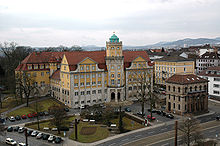Hessian State Museum (Kassel)

The Hessian State Museum in Kassel is located on Brüder-Grimm-Platz , on the edge of the city center and the beginning of Wilhelmshöher Allee . From 2008 to 2016 the museum was closed for renovation work. In the Hessian State Museum, over 6000 objects from the collections of prehistory, applied art and folklore are presented on three levels with around 3800 m² of exhibition space.
history
Designed by the architect Theodor Fischer , the museum was inaugurated on August 23, 1913, for the millennium of the city of Kassel. The architect's historicizing design was based on Hessian monuments from the late Renaissance. Apart from the dominant, centrally placed tower, the building has the traditional floor plan of an art museum based on Friedrich Schinkel's functional model: a five-wing complex with two inner courtyards. In contrast to the almost complete destruction of the nearby Kassel city center, the building survived the Second World War with only minor damage. This is why the Old Masters Picture Gallery was added there in the early post-war period . From 1946 to 1948 the Hessian Secession exhibited in the gallery rooms of the Hessian State Museum. After the reconstruction of the Neue Galerie and Wilhelmshöhe Palace , the collections of the Kassel museums were reorganized in the 1970s.
Collections in the Hessian State Museum
Prehistory and early history
Landgrave Karl near Gudensberg had grave mounds examined as early as 1704 . These and later finds have been on display in the Hessian State Museum since 1913. The majority of the North Hessian artefacts are still in this Kassel collection. There are finds from all time periods on the history and development of the North Hessian area in the period before the first written sources began. The range extends from finds from the Paleolithic and Middle Stone Age (from around 800,000 BC) to the Neolithic (approx. 5,500–2,200 BC), the Bronze and Iron Ages (approx. 2,200 BC – 450 AD) to the early Middle Ages (approx. 450 AD – 900 AD).
applied Arts
The core holdings of the Applied Arts Collection (formerly arts and crafts and sculpture ) are the Hessian Landgraves ' collection , which had previously been exhibited in the Fridericianum . The collection includes medieval sculptures, altars, cabaret and sacred objects. In addition, large parts of the treasury and the silver chamber, but also treasures of the art chamber of Wilhelm IV and Moritz the scholar. In addition, baroque art from the court of Landgrave Karl, a historical glass collection from Wilhelm VIII as well as a historical amber collection, an ivory collection, Hessian faience, porcelain from Meissen, Kassel, Fulda and exhibits from the princely porcelain gallery from China and Japan. The holdings of jewelry, sculptures, textiles, furniture and the Hessian Coin Cabinet with coins, medals and gems are also extensive. The Applied Art Collection from 1840 shows historicism, Art Nouveau and modern art. Design is represented from the Bauhaus through the 1950s to 1980s of the 20th century to postmodernism.
Folklore
The folklore collection is the largest in Hesse. The focus is on the areas of traditional costume, pre-industrial work, living and toys. Its beginnings lie in the 19th century, when the national consciousness of the bourgeoisie led to a reflection on the cultural values of their own people. In the museum opened in 1913, folklore was thus also an expression of a new museum concept that emphasized the care of local antiquities. After losses in World War II, the stock increased again later. No exhibition rooms have been available since 1980. The folklore collection was therefore completely stored and could only be presented in parts in special exhibitions and publications.
Former collections in the Hessian State Museum
German Wallpaper Museum
The German Wallpaper Museum documented the history of wallcovering and comprised around 23,000 objects. It was founded in 1923 on the initiative of the wallpaper dealer Gustav Iven. After the wallpaper museum had already exhibited its exhibits at other locations in Kassel, the collection moved to the Hessian State Museum in 1976. In 1993 the museum, which had been privately run until then, was passed on to the State of Hesse. When the renovation work began in 2008, the museum was closed.
A new museum building with a contemporary permanent exhibition is currently being planned for the unique wallpaper collection. Therefore, the collection is currently only accessible via an online catalog.
Exhibitions
- 2017/2018: Bible in iron. Biblical motifs on stove tops from the 16th century . Catalog.
See also
Web links
- Official website of the Hessian State Museum Kassel
- Official blog of the Hessian State Museum Kassel
- Hessian State Museum Kassel . In: Museen-in-Hessen.de
- Hessian State Museum with gate guard . In: Website of the city of Kassel
Individual evidence
- ↑ State Museum in Kassel will reopen at the end of November , HNA from August 25, 2016, accessed on August 26, 2016
- ↑ Hessian State Museum with gate guard. In: Kassel.de. Retrieved December 1, 2017 .
- ^ The new Hessian State Museum in Cassel . In: Zentralblatt der Bauverwaltung . Born in 1913, urn : nbn: de: kobv: 109-opus-47495 , pp. 629–631 and pp. 637–638. (With illustrations, floor plans and plans)
- ↑ Hessisches Landesmuseum. Brothers Grimm Square. Museum landscape Hessen Kassel, accessed on May 17, 2015 .
- ↑ Collections. Prehistory and early history. Hessian State Museum. Museum landscape Hessen Kassel, accessed on May 17, 2015 .
- ↑ Collections. Applied Arts Collection. Hessian State Museum. Museum landscape Hessen Kassel, accessed on May 17, 2015 .
- ↑ Collections. Folklore. Hessian State Museum. Museum landscape Hessen Kassel, accessed on May 17, 2015 .
- ↑ Collections. German Wallpaper Museum. Hessian State Museum. Museum landscape Hessen Kassel, accessed on May 17, 2015 .
Coordinates: 51 ° 18 ′ 39 " N , 9 ° 29 ′ 23" E